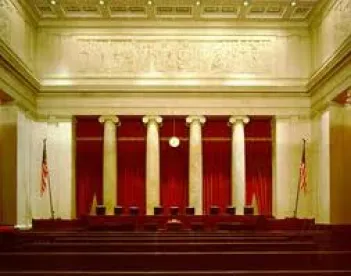High Court's decision provides companies with a significant and rational defense to class certification in antitrust and other damages class actions.
On March 27, in Comcast Corp. v. Behrend, No. 11-864 (U.S. Mar. 27, 2013), available at http://www.supremecourt.gov/opinions/12pdf/11-864_k537.pdf, the U.S. Supreme Court reaffirmed that district courts must undertake a "rigorous analysis" of whether a putative class satisfies the predominance criterion set forth in Federal Rule of Civil Procedure 23(b)(3), even if that analysis overlaps with the merits of the underlying claims, and held that individual issues of damages may preclude class certification. This decision provides companies with a significant and rational defense to class certification in antitrust and other damages class actions.
In reversing the class certification, the Court clarified at least four critical points. First, the Court emphasized that it may be necessary for the trial court to review the evidence offered by the plaintiffs to determine whether the requirements of the class-certification rule have been satisfied and that it is legal error for a trial court to decline to review that evidence simply because it relates to the merits of the case. Second, the Court built upon the decision in Wal-Mart Stores, Inc. v. Dukes, 131 S. Ct. 2541 (U.S. 2011), and noted that the "predominance" requirement applicable to damages class actions is "even more demanding" than in other types of class actions. Comcast, slip op. at 6. Third, it rejected as insufficient the expert evidence offered by the plaintiffs that was not reasonably tied to their theory of liability. Fourth, and perhaps most importantly, the Court found that questions of individual alleged damages against Comcast "will inevitably overwhelm questions common to the class." Id. at 7.
This last point is particularly significant, as it should counter an approach by plaintiffs—frequently used in damages class actions—to pursue only one theory of damages and disavow claims for individual additional or different damages over and above the alleged classwide theory. Justice Antonin Scalia's majority opinion and rationale in Comcast may help to establish the inappropriateness of that approach and limit damages class actions to those cases where all class members truly suffered the same injury.
Background and Summary
Subscribers to Comcast's cable television services brought a class action against the company, alleging that Comcast's clustering of operations, in violation of federal antitrust laws, eliminated competition and led to supra-competitive prices in the Philadelphia region. The plaintiffs sought certification of a purported class of two million current and former Comcast subscribers under Federal Rule of Civil Procedure 23(b)(3), which requires among other things that "questions of law or fact common to class members predominate over any questions affecting only individual members[.]"
The plaintiffs advanced four theories of individual injury (or antitrust impact). The U.S. District Court for the Eastern District of Pennsylvania accepted only one of the plaintiffs' four theories—described as the "overbuilder theory"—as capable of classwide proof. The district court held that a damages model prepared by the plaintiffs' expert, Dr. James McClave (the McClave model), provided an adequate methodology to measure damages on a classwide basis.
The McClave model, however, did not calculate the plaintiffs' alleged damages specific to the overbuilder theory. It instead included damages for all four theories of liability, including the three that had been rejected by the district court. Although the McClave model did not isolate damages resulting from the overbuilder theory of antitrust impact, the district court certified the class.
On appeal, the U.S. Court of Appeals for the Third Circuit refused even to entertain Comcast's argument that the class was improperly certified because the McClave model failed to tie its damages calculation to the overbuilder theory. A divided Third Circuit affirmed the district court, concluding that Comcast's "attack[] on the merits of the methodology [had] no place in the class certification inquiry." Behrend v. Comcast Corp., 655 F.3d 182, 207 (3d Cir. 2011).
In a 5-4 decision authored by Justice Scalia, the Supreme Court reversed, holding that the class had been improperly certified. The majority concluded that the Third Circuit erred by failing to consider the individual issues presented by the plaintiffs' damages evidence simply because, in the Third Circuit's view, those arguments would also be pertinent to the merits determination. The Court found that the Third Circuit's approach "flatly contradict[ed]" its prior guidance—most recently articulated in Wal-Mart—which requires a rigorous analysis into whether Rule 23 is satisfied, even if that analysis involves an inquiry into the merits of the claims. Comcast, slip op. at 8. Thus, the Court reaffirmed its holding that lower courts may need to look beyond the pleadings when analyzing the propriety of class certification in order to assess how merits issues may impact whether Rule 23's requirements are satisfied.
The Court also built upon its prior decision in Wal-Mart, noting that the "same analytical principles" are not only applicable in damages class actions, but also that "Rule 23(b)(3)'s predominance criterion is even more demanding than Rule 23(a)." Id. at 6.
Turning to the specific evidence in Comcast, the Court noted that the different damages theories offered by the plaintiffs revealed important differences among class members, that the McClave model failed to account for the damages that allegedly resulted solely from the "overbuilder theory," and that the Third Circuit had erred in failing to determine whether the plaintiffs' damages methodology was "just and reasonable" or merely speculative and thus could not satisfy Rule 23(b)(3)'s predominance requirement. The Court noted that, under the Third Circuit's logic, "at the class certification stage, any method of measurement is acceptable so long as it can be applied class-wide, no matter how arbitrary the measurements may be. Such a proposition would reduce Rule 23(b)(3)'s predominance requirement to a nullity." Id.at 8. Applying the proper standards to the record before it, the Court held that the damages model could not demonstrate that damages could be measured on a classwide basis.
Analysis of Key Points
It was widely thought that the Court would use Comcast to decide the standard for the admissibility of an expert's opinion at the class-certification stage and, in particular, whether Daubert v. Merrell Dow Pharmaceuticals, Inc., 509 U.S. 579 (1993)—the standard governing the admissibility of expert testimony at trial—applies at the class-certification stage. Despite extensive briefing of the issue, the Court did not decide whether the Daubert standard or some other level of scrutiny applies at the class-certification stage. That question remains open in light of Wal-Mart, in which Justice Scalia strongly suggested that Daubert is the appropriate standard at class certification.
Instead, writing for the majority, Justice Scalia framed the Comcast case as a "straightforward application of class-certification principles" and not as an issue of whether the plaintiffs' expert evidence was admissible.Comcast, slip op. at 7.
The majority noted that a plaintiff seeking certification of a class bears the burden of satisfying "through evidentiary proof" at least one of the provisions of Rule 23(b) and emphasized that the Court has "[r]epeatedly" instructed that district courts may need to look beyond the pleadings in analyzing class-certification motions. Id. at 5–6 (citing Wal-Mart, 131 S. Ct. at 2551; Gen. Tel. Co. of the Sw. v. Falcon, 457 U.S. 147, 160–61 (1982)).
This instruction applies with equal force to the requirements of both Rule 23(a) and Rule 23(b). In fact, the Court noted that the predominance criterion of Rule 23(b)(3) is even more demanding than Rule 23(a). Citing its decision in Wal-Mart, the Court also reiterated the unique status of Rule 23(b)(3) as "an adventuresome innovation" that was "designed for situations in which class-action treatment is not as clearly called for."Id. at 6 (internal quotations omitted). Thus, district courts have a duty to "take a 'close look' at whether common questions predominate over individual ones." Id.
The majority also strongly reaffirmed that a district court's "rigorous analysis" of the Rule 23 factors "will frequently entail 'overlap with the merits of the plaintiff's underlying claims.'" Id. at 6 (quoting Wal-Mart, 131 S. Ct. at 2551). Indeed, the Court expressly recognized that "class determination generally involves considerations that are enmeshed in the factual and legal issues comprising the plaintiff's cause of action." Id.at 6 (internal quotations omitted). Viewed in the context of Rule 23's requirements and starting from the "unremarkable premise" that a model of damages in a class action must measure only the damages attributable to plaintiffs' particular theory of liability, the Court criticized the rationale of the Third Circuit opinion for "simply conclud[ing]" that the plaintiffs articulated a classwide damages theory without analyzing "'whether the methodology [was] a just and reasonable inference or speculative.'" Id. at 7–8 (quoting Behrend, 655 F.3d at 206).
The Court found that, according to the Third Circuit's erroneous logic, "any method of measurement is acceptable as long as it could be applied classwide, no matter how arbitrary the measurements may be." Id. at 8. The Court instructed that "'[t]he first step in a damages study is the translation of the legal theory of the harmful event into an analysis of the economic impact of that event.'" Id. at 11 (quoting Federal Judicial Center, Reference Manual on Scientific Evidence 432 (3d ed. 2011)). The district court and the Third Circuit "ignored th[is] first step entirely" and therefore could not be assured that damages could be proved on a classwide basis and that individualized issues would not overwhelm common issues. Id.
The Court also suggested that even if the plaintiffs had tied their expert damages evidence to the overbuilder theory, differences in the nature and type of damages suffered by members of the class could defeat class certification because class members in different regions within the class may have experienced different alleged harm. The Court also included a potentially significant note that, even assuming the McClave model had been able to identify those "subscribers who paid more solely because of the deterrence of overbuilding," it would not have established the commonality of damages required to satisfy Rule 23 unless it also "plausibly showed" that the extent of antitrust impact was the same across all counties or irrelevant to Comcast's ability to charge allegedly anticompetitive prices. Id. at 10–11 n.6. The Court's view is clear: Damages evidence must be closely scrutinized at the class-certification stage and may be sufficiently individualized as to defeat class certification.
Dissent Offers a Limited View of the Majority Opinion
Justices Ruth Bader Ginsburg and Stephen Breyer, jointly writing for the dissent, argued that the Court should have dismissed the writ of certiorari as improvidently granted. The dissent believed that, because the parties' briefing had focused on the admissibility of expert evidence at the class-certification stage, the Court should not have decided whether the plaintiffs' damages model was adequate to support class certification. In reaching that issue, according to the dissent, the Court had improperly overturned the factual findings of both the lower courts and misapplied substantive antitrust law. Moreover, the dissent noted that the plaintiffs never challenged the need to prove damages on a classwide basis through a common methodology. As a result, the dissent cautioned that the Court's decision "should not be read to require, as a prerequisite to certification, that damages attributable to a classwide injury be measurable on a classwide basis." Id. at 3 (Ginsburg and Breyer, J.J., dissenting) (internal quotations omitted).
Implications for Class Litigation
The Court's decision reaffirms critical aspects of its prior precedents, including Wal-Mart. Specifically, the Court's opinion underscores that district courts must critically examine damages methodologies to determine whether they are based on just and reasonable inferences and are not merely speculative and that individual issues of damages may require the denial of class certification. This is necessary to ensure that only those cases that are truly capable of collective resolution will be certified as class actions. Putative Rule 23(b)(3) class actions merit especially close scrutiny.
As with many Supreme Court decisions, litigants and the lower courts will grapple with determining the full impact of Comcast, but the majority's opinion provides an important precedent for companies defending damages class actions.




 />i
/>i

